That first cup of coffee I drink literally sets the tone for my entire day. As a mother of three little ones, I really look forward to my morning coffee, which I’m usually sipping while packing lunches and rounding up my family to get out the door.
When I need an extra dose of comfort and support, and especially if I know that I’m not going to have time to eat a sit-down breakfast, then this cinnamon coconut latte has become a lifesaver for me. I created this recipe back in the day when bulletproof coffee and Whole30 were in their prime. And I still drink it occasionally because it’s just so darn delicious.

Recipe Highlights
For me, there are few things more satisfying than that first cup of joe I drink in the morning. Since purchasing an espresso machine, I’ve gotten even more adventurous and discerning with my coffee drinks. This coconut latte doesn’t require an espresso machine, but I promise you that it tastes just like it was made in your favorite coffee shop.
- First and foremost, I love this latte because it is simply delicious. I find it to be so cozy and comforting, and I really enjoy every last drop.
- This coffee is high in fat because of the additions of coconut oil and butter. While I don’t drink this latte every morning, that extra bit of fat makes it truly filling when I do make one, and it tides me over until lunch. I know people who drink this latte instead of eating breakfast. And even though I’m an advocate for eating a healthy breakfast, I’m also realistic and know that it’s just not possible or appealing for everyone out there.
- I love that this latte is super creamy without the addition of cream. Since this recipe is blended, it gets a nice frothiness to it, even if you leave out the ¼ cup of milk.
- With a few simple swaps, it’s easy to make this a dairy-free latte for those with dietary needs, such as avoiding dairy, with lactose intolerance, or those who want a vegan latte.
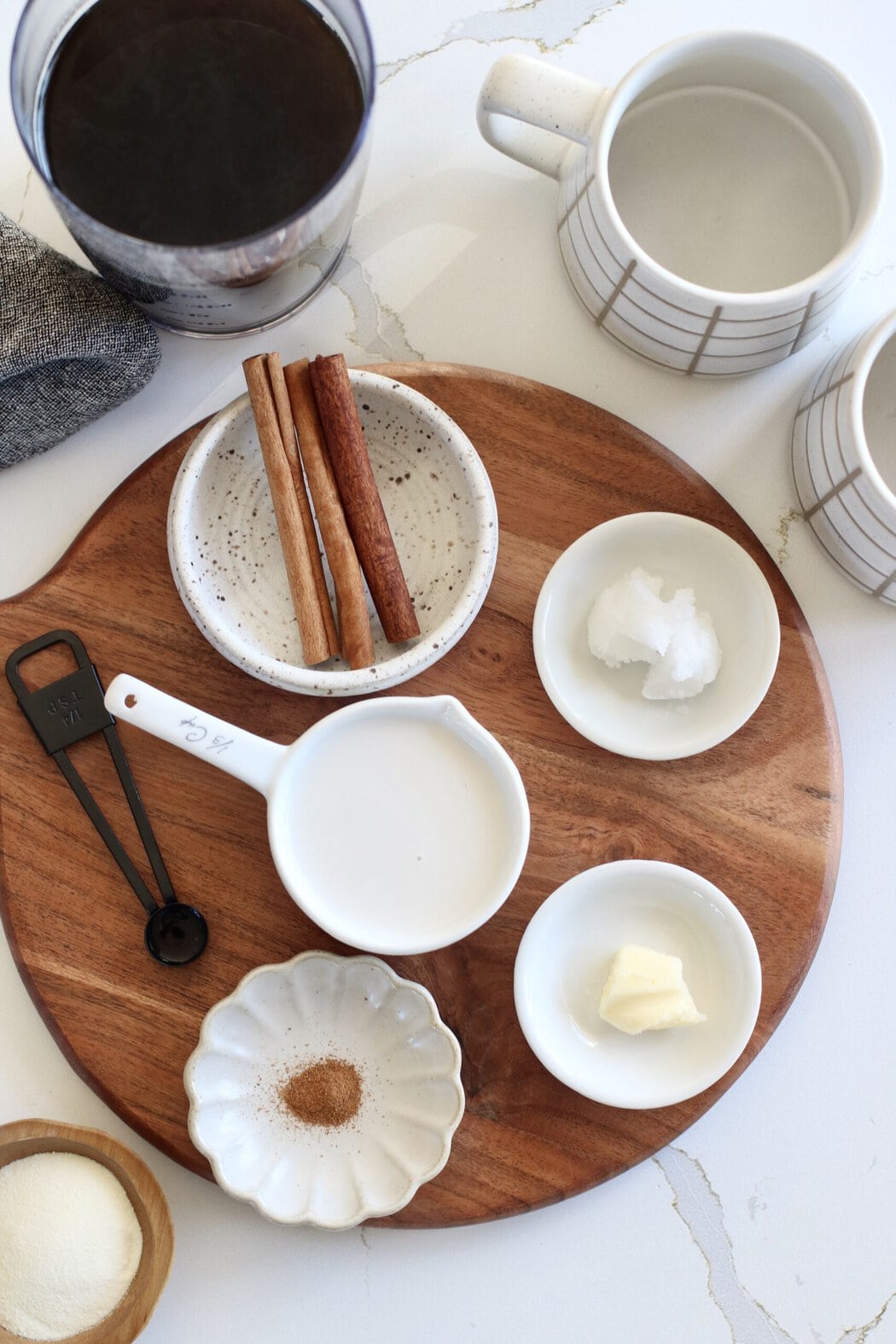
Ingredients To Make A Cinnamon Coconut Latte
Here’s what it takes to make one of these cinnamon lattes at home today:
- High-quality, organic coffee – this latte starts with brewing a mug of strong coffee (here’s how I found the best coffee)
- Coconut oil – this plant-based oil is rich in medium-chain triglycerides, which are metabolized differently than other fats making them a quicker source of energy). It also gives this drink a mild and pleasant coconut taste.
- Butter – butter and ghee (a type of clarified butter) are a rich source of several vitamins including vitamins A, D, E, B12, and K2. I usually buy Organic Valley grass-fed butter for use at home. For dairy-free, use an extra teaspoon of coconut oil instead of butter.
- Milk – adding a splash of milk (non-dairy or dairy) is optional but gives this cinnamon coconut latte an extra bit of creaminess. I like it with both 2% dairy and full-fat milk, and I also think almond milk, oat milk, and coconut milk are especially good and match the cinnamon flavor profile well.
- Ground cinnamon – this spice is loaded with antioxidants that may help fight inflammation, so in this warm drink it’s providing both flavor and benefits. Blend ¼ to ½ teaspoon cinnamon into the latte and sprinkle a dash more on top for garnish.
- Vanilla extract – pure vanilla extract helps make this sugar-free beverage taste a little sweet despite the absence of any added sweeteners. Of course, if you’d like yours sweeter, feel free to add a little honey or maple syrup before blending.
- Collagen (optional)– I’ll often add a scoop of high-quality collagen to increase the protein in this latte, especially when I know I’m not going to get other breakfast foods right away. I mostly use the Puori CP1 collagen peptides, which adds 9 grams of protein per scoop.
Find the ingredient list with exact measurements in the recipe card below.
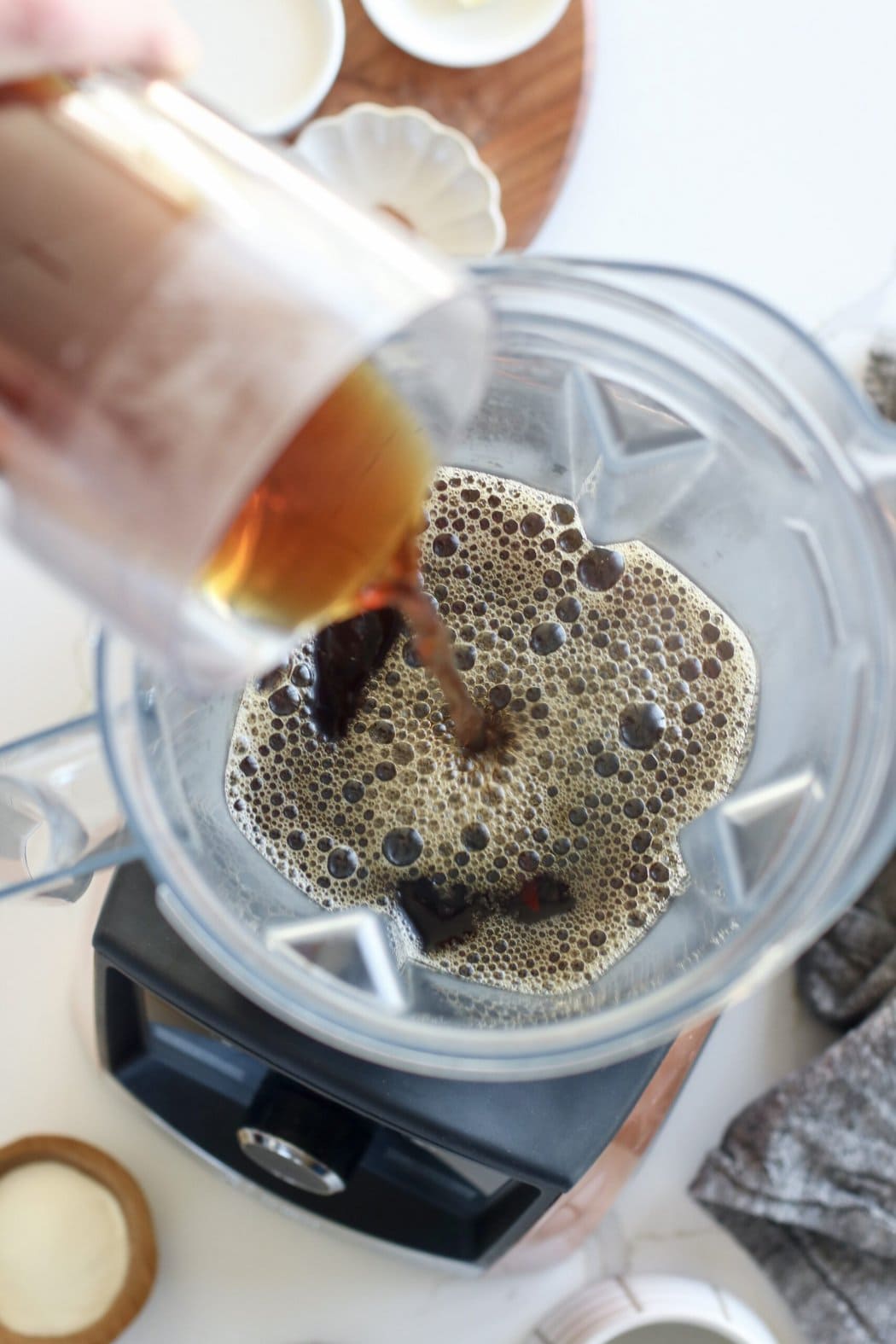
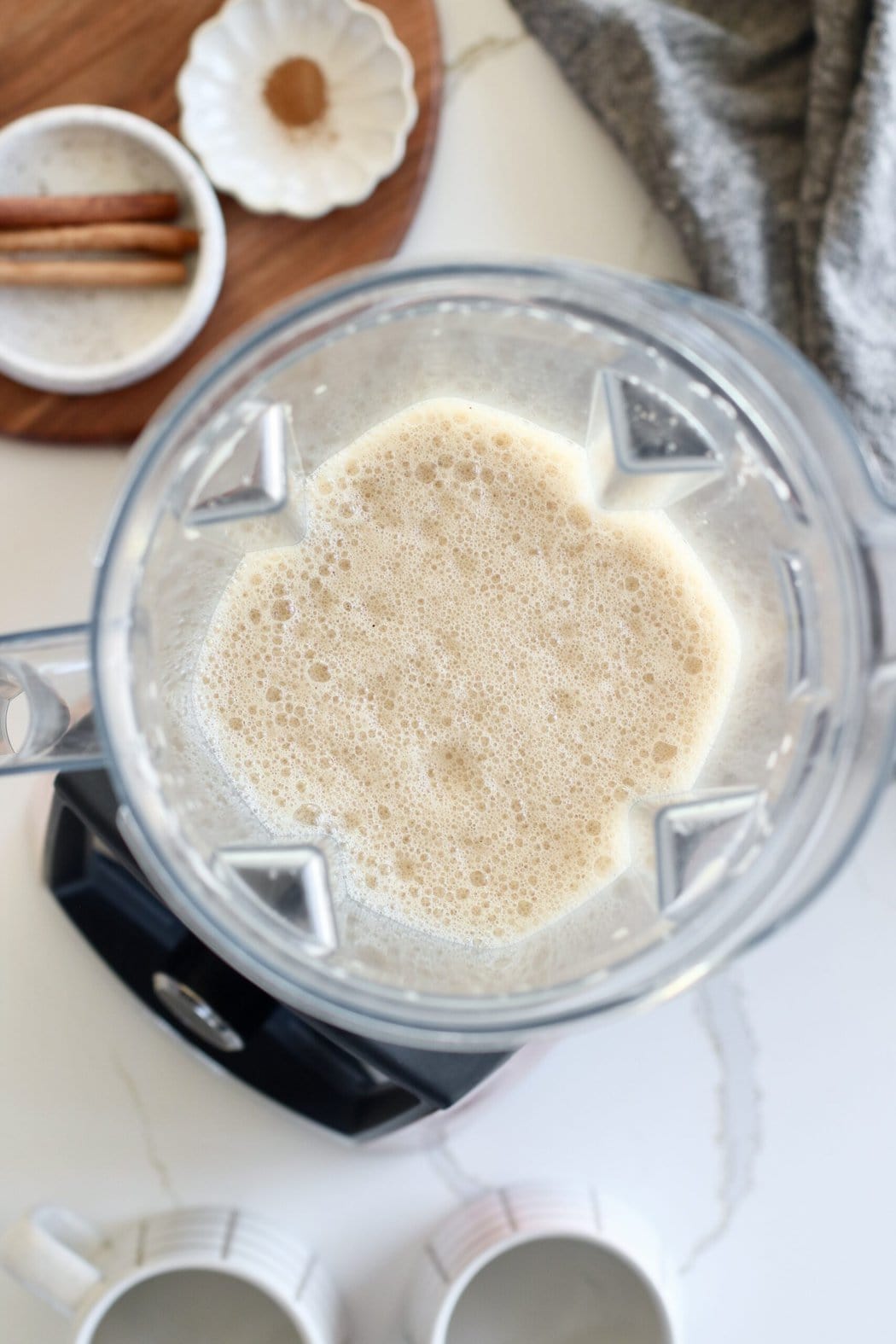
Why The Extra Fat?
Normally coffee is served with breakfast. But, let’s be honest, sometimes it IS breakfast—especially for busy parents, entrepreneurs, workers with long commutes, and people who just aren’t a fan of eating breakfast.
As a registered dietitian, I aim to eat a high-protein breakfast on most days. And though I’ve tried it in the past, I don’t actively follow the practice of intermittent fasting. But, as a working mom, sometimes it just happens. When I’m busy taking care of everyone else’s needs in the morning, sometimes all I can manage is to make myself a coffee and grab a protein bar on my way out the door. On days like that, adding a little extra fat to my morning coffee helps me fend off the ‘hangries’ and stabilize my blood sugar. It keeps me going for a couple of hours until I can sit down for a real breakfast or lunch.
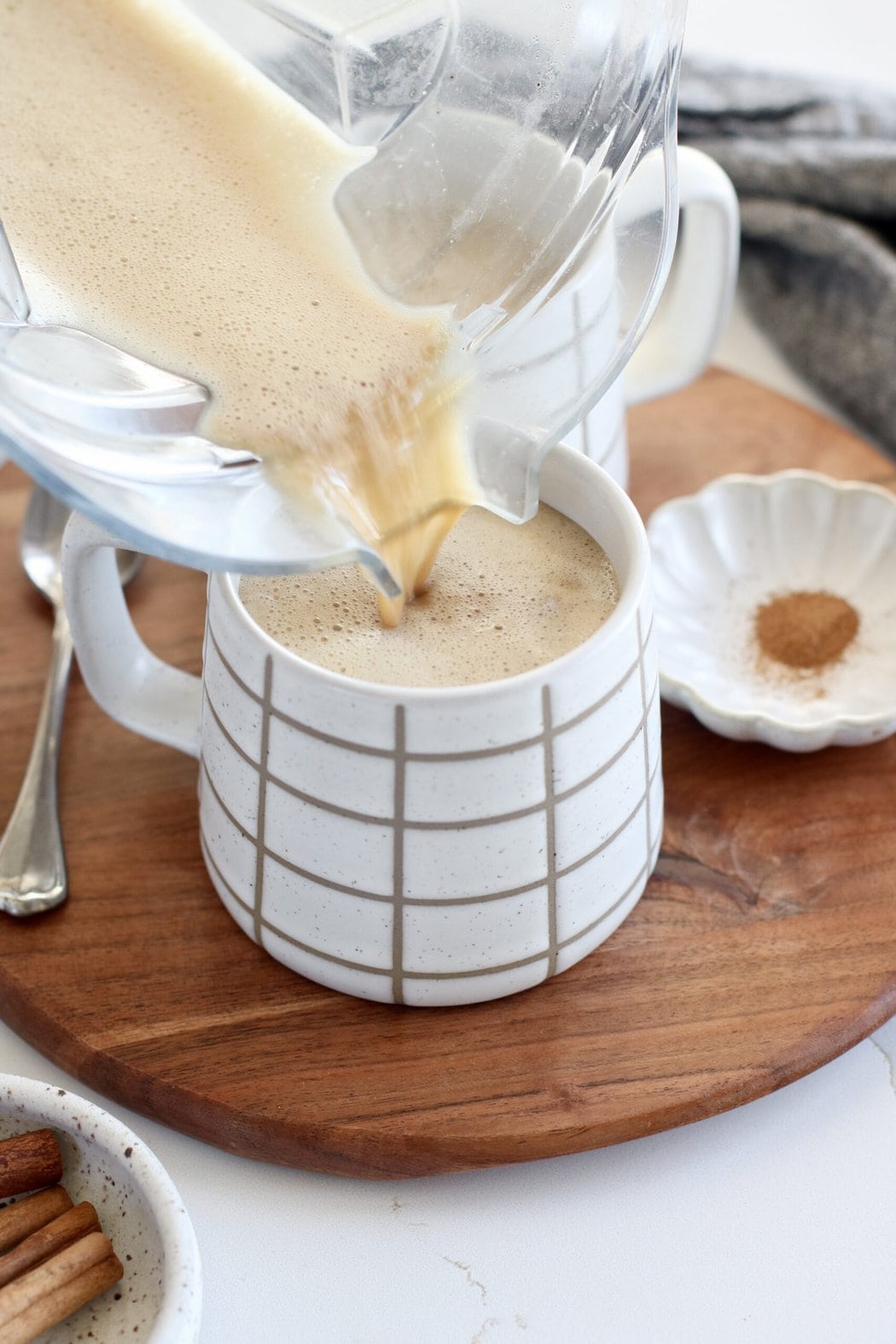
Make It Dairy Free
It’s easy to make this a dairy-free latte. To do so, omit the butter and use a plant-based milk. I especially like coconut milk, oat milk, and almond milk in this latte. They all froth well using my blender method.
Make It Vegan
For a vegan latte, omit the butter and just use coconut oil. Use a plant-based milk, and omit the optional collagen peptides.
Equipment You’ll Need
You don’t need a fancy espresso machine to make this latte. What you do need is a coffee maker so you can brew some coffee, and also a high-speed blender. If you don’t have a blender, I list a few more options you can use instead below.

Blend It Up
The secret to this super creamy, quick, and easy latte is blending it in a high-speed blender. If you don’t have one of those, you can use an immersion blender (I recommend blending it in a jar rather than your cup to prevent a sloshy mess). You can also use a battery-operated handheld frother, but you won’t get as much thick and creamy froth on top.
Here’s a pro tip from a reader who has made this recipe before: Blend a double or triple batch at once, and then refrigerate what you don’t drink. When you want a super quick latte, just reheat it on the stovetop or in the microwave until everything melts together again.
For serving size and the complete directions and ingredient amounts, scroll down to the recipe card below. All of our recipes include the nutrition analysis, listing calories (kcals), protein, carbohydrates/carb, fiber, sugar, sodium, cholesterol, and more per serving.
Want to save this recipe?
Enter your email below & we’ll send it straight to your inbox. Plus you’ll get great new recipes from us every week!

Cinnamon Coconut Latte
This delicious latte blends the flavors of cinnamon and coconut, and I think it’s a match made in heaven. By using a blender method, you can get a creamy frothy latte, even when using dairy-free ingredients.
Ingredients
- 12 ounces strong brewed coffee (my favorite)
- 2 teaspoons coconut oil
- ½–1 teaspoon unsalted grass-fed butter
- ¼–½ teaspoon ground cinnamon
- ¼–⅓ cup dairy or unsweetened non-dairy milk of choice
- ⅛ teaspoon pure vanilla extract
- 1 scoop collagen peptides (optional)
Instructions
- Brew coffee in a coffee maker or French press.
- To a blender, add the brewed coffee, coconut oil, butter, cinnamon, milk, and vanilla (and collagen, if using) Blend on high for 15-30 seconds until creamy and frothy.
- Pour into a coffee mug, dust with additional cinnamon and enjoy while still warm.
Last Step! Please leave a review and rating letting us know how you liked this recipe! This helps our business thrive so we can continue providing free recipes and high-quality content for you.
Notes
For dairy-free and vegan, omit the butter and use coconut oil instead and use a plant-based milk (I like coconut milk, oat milk, and almond milk in this latte). Also, for vegan, omit the collagen peptides.
If adding 1 scoop of collagen peptides, it will add about 35 calories, 50 mg sodium, and 9 grams of protein to the nutrition analysis listed below.
Nutrition Information
- Serving Size: 1 latte (made with dairy-free milk)
- Calories: 115
- Fat: 12 g
- (Sat Fat: 8 g)
- Sodium: 71 mg
- Carbohydrate: 1 g
- (Fiber: 0 g
- Sugar: 0 g)
- Protein: 1 g
- Cholesterol: 5 mg
Dietary
For ultimate success, we highly recommend reading the tips in the full blog post above. All photos and content are copyright protected. Please do not use our photos without prior written permission. If you wish to republish a recipe, please rewrite the recipe in your own unique words. Link back to the source recipe here on The Real Food Dietitians. Thank you!
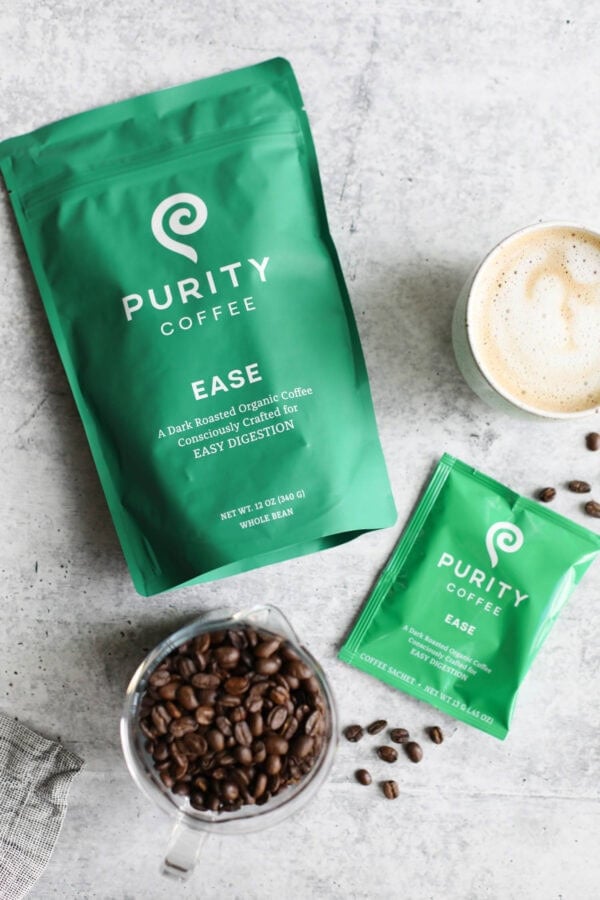


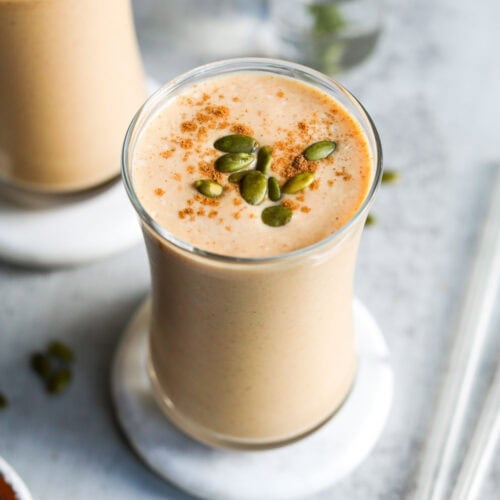
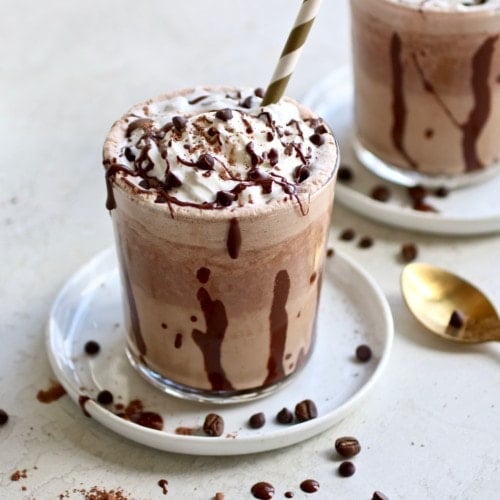


This does not explain why or how the recipe is “gut healing.”
What is the real benefit of this? It seems like an advertisement to sell products, but it doesn’t tell me why I should spend money on processed products instead of using real whole ingredients to make my food.
Hi Barbara,
Thanks for taking the the time to comment and ask a question. To answer your question, collagen peptides support gut health by helping to build and maintain a healthy gut barrier which in turn supports good digestion. Glutamine and glycine, two amino acids abundant in gelatin and collagen peptides, are essential for healthy digestion. Glutamine is the preferred fuel for cellular reproduction in the gut and supports the healing and growth of new cells and the tissue that makes up your intestinal tract. Glycine contributes to the production of bile salts (to help you digest fat) and adequate gastric acid secretion in the stomach which is another vital function that decreases as you age.
And in the spirit of total transparency, we did receive compensation for this post and may receive an affiliate commission for each sale, however, our opinions of the product are 100% our own. We only promote products we stand by 100% and use in our daily lives. Receiving compensation for posts such as this one makes it possible to provide free recipes and content to our readers without having to purchase a cookbook, membership or subscription because blogging, hosting and site maintenance aren’t free.
I have a question, is the Vital Proteins collagen peptides basically the equivalent to powdered goodness of bone broth??
Thank you,
Amy
Hi Amy,
Yes, that’s pretty much the gist of it. However, bone broth also contains other minerals that wouldn’t be present in the collagen peptides (like calcium, phosphorus and magnesium to name a few). But if it’s the gelatin/collagen that you’re looking for then this is the ticket.
Hope that helps!
That’s exactly what I was hoping you’d say 🙂
Yay!!
I drink this exact drink every morning except also add 1/4 tsp turmeric and pinch of black pepper to it. Thinking about trying it with ground matcha tea instead of the coffee.
Hi Dee!
I love the addition of turmeric and the black pepper to enhance absorption of the turmeric. I often make this with matcha and it’s heavenly!
Cheers!
I just made this recipe minus the collagen since I didn’t have any at hand. It’s simple and fantastic! I love lattes, especially when you don’t have to leave the house for them!
Hi Elisha,
Great to hear that you loved this recipe. I love a good almond or coconut milk latte too but you’re right – leaving the house (and dropping 5+ bucks on one) isn’t always in the plan for me either.
Hi Jessica,
thanks for your delicous recipe! I already put coconut oil in my coffees or hot chock with coconut milk, cacao and cinnamon powder. Its devine!! So im very excited about adding the gelatin as well. Only thing is I have the vital proteins beef gelatin powder, not the collagen peptides. Will it still work the same way?
Thanks
Hi Laurinda,
Thank you for your kind words. The gelatin will work in hot beverages like coffee, tea and hot cocoa but will start to thicken when the beverage cools.
For best results, try mixing the gelatin powder with a bit of hot water or other liquid first before adding it to your cup (blending will also help which I’m assuming you already do since you’re adding coconut oil too).